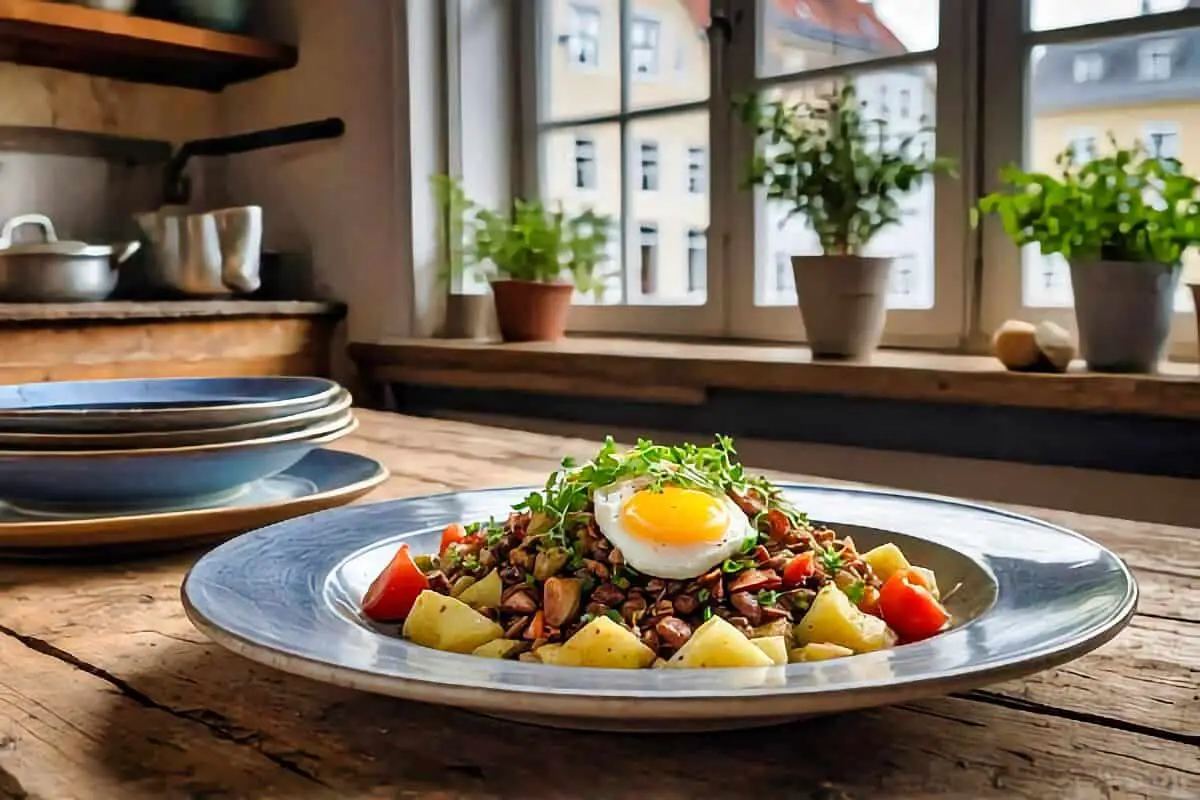I learned how to make the Danish Biksemad recipe during my trip to Kolding, Denmark. This dish is a classic comfort food in Denmark, known for its hearty and filling ingredients. It consists of diced potatoes, meat, onions, and a fried egg on top, served with pickled beets and sometimes a side of ketchup. The Danish Biksemad recipe is often enjoyed as a quick and satisfying meal, especially for lunch or dinner.
Kolding is a charming town in southern Denmark, known for its beautiful mix of historical and modern architecture. One of the main attractions in the area is Koldinghus, a medieval castle turned museum. Walking around the town, you’ll notice the picturesque streets lined with local shops and cafes. The town is quite walkable, with easy access to parks and the Kolding Fjord, which provides a scenic backdrop to the area. The town blends both traditional Danish architecture with more contemporary designs, making it an interesting place to explore.
The Danish Biksemad recipe is widely known and loved in Denmark. It is a dish that originated as a way to use leftover meat and potatoes, making it a practical and resourceful meal. When I first tried it, I was struck by how simple yet filling the dish was. The potatoes were perfectly crisp on the outside, with a soft interior, while the meat added a savory depth of flavor. The onions were slightly caramelized, providing a subtle sweetness that balanced out the richness of the fried egg on top.
As for the texture, the dish was a comforting combination of crunchy, tender, and smooth elements. The pickled beets added a tangy contrast, cutting through the heaviness of the other ingredients. The egg, with its runny yolk, added a creamy richness to the entire dish. It was evident why the Danish Biksemad recipe is so popular with locals. It’s a dish that’s both satisfying and adaptable, allowing for variations depending on what ingredients are available.
The Danish Biksemad recipe is especially popular among Danes on weekends or holidays, where it’s often made as a quick and easy meal to enjoy with family and friends. It’s not only practical, but it also brings people together around the table, making it an important part of Danish food culture. After learning how to prepare it, I could see why it has remained a staple in Danish households for so many years.
Ingredients
Butter
Onions
Potatoes
Pork or Sausage
Salt
Pepper
Eggs
Cooking Instructions
- In a skillet, melt half of the butter.
- Before they get golden, add the onions and sauté.
- Take it out of the pan and set aside to stay warm.
- Saute the potatoes in the skillet with the leftover butter until they start to brown.
- Saute the meat for two or three minutes.
- Once everything is heated through, add the onions and continue cooking.
- Although it isn’t required for the dish, a lightly cooked egg is a tasty addition when placed on top of the hash.

Healthy Eating Options in Denmark
Denmark is renowned for its commitment to healthy eating, which is deeply rooted in its food culture and lifestyle. Danish cuisine emphasises fresh, locally sourced, and seasonal ingredients, which contribute significantly to its health benefits. This approach ensures that the food retains its nutritional value while offering a rich variety of flavours and textures. The emphasis on balance and moderation in Danish cooking also makes it easier to maintain a healthy diet without feeling deprived.
One of the key reasons Danish food is considered healthy is its reliance on whole grains, particularly rye. Rye bread (*rugbrød*), a staple in Denmark, is high in fibre and nutrients, promoting good digestion and providing long-lasting energy. This dense, hearty bread often forms the base for open-faced sandwiches (*smørrebrød*), which are typically topped with lean proteins, fresh vegetables, and healthy fats like fish.
Seafood plays a central role in Danish cuisine, with fish such as herring, salmon, and cod being popular choices. These fish are rich in omega-3 fatty acids, which are beneficial for heart health and brain function. They are often prepared simply—grilled, pickled, or smoked—allowing the natural flavours and nutritional qualities to shine through.
Vegetables also take centre stage in Danish meals, whether in the form of salads, roasted root vegetables, or pickled accompaniments. Seasonal produce ensures that the vegetables are fresh and nutrient-dense. Pickled vegetables, a common side dish, not only add a tangy flavour to meals but also provide probiotics that support gut health.
Denmark’s approach to dairy products is another aspect that contributes to its healthy eating reputation. High-quality butter, cheese, and yoghurt are used sparingly to enhance dishes rather than overwhelm them, ensuring a balance of flavours and nutrients.
Portion control and the cultural emphasis on enjoying meals slowly and socially are additional factors that make Danish eating habits healthier. The Danish concept of *hygge*—creating a cosy, enjoyable atmosphere—encourages mindful eating, which has been shown to support better digestion and overall well-being.
Danish food is healthy because it prioritises fresh, whole ingredients, minimal processing, and balanced meals. This focus, combined with an active lifestyle and mindful eating practices, makes Denmark an excellent example of how food can nourish both the body and the soul.
How to Find Local Food Favorites in Denmark
Copenhagen, Denmark’s vibrant capital, is a hub for culinary exploration, blending traditional Nordic dishes with modern food trends. For visitors looking to experience the best local food spots, the key lies in seeking out places that prioritise fresh, seasonal ingredients and authentic Danish flavours. While the city offers numerous high-end restaurants, including several Michelin-starred establishments, some of the most memorable dining experiences can be found at more casual and locally loved spots.
One of the best ways to uncover Copenhagen’s food gems is by exploring the city’s bustling food markets. Torvehallerne, an indoor food market located in the heart of Copenhagen, is a treasure trove of Danish delicacies. Here, you’ll find vendors selling everything from traditional *smørrebrød* (open-faced sandwiches) to freshly baked pastries like *kanelsnegle*. For a truly local experience, try sampling fresh fish or locally crafted cheeses. These markets also provide the opportunity to interact with the vendors, who often have great recommendations for nearby hidden gems.
Walking through the city’s diverse neighbourhoods is another effective way to find authentic food experiences. Nørrebro, known for its multicultural flair, offers a range of eateries serving both traditional Danish fare and creative fusion cuisine. Meanwhile, the Christianshavn neighbourhood boasts charming canalside cafes where you can enjoy classic dishes like *frikadeller* (Danish meatballs) or *flæskesteg* (roast pork with crackling).
If you prefer guided insights, consider joining a local food tour. Many tours in Copenhagen focus on showcasing the city’s culinary highlights, often including visits to lesser-known spots that tourists might overlook. These tours are an excellent way to sample a variety of Danish foods while learning about their history and significance.
Social media and review platforms like Instagram and TripAdvisor can also point you toward popular local favourites. Look for posts and reviews from locals rather than tourists to get authentic recommendations. Many Copenhagen residents share their dining experiences online, making it easier to discover hidden treasures off the beaten path.
Don’t overlook Copenhagen’s bakeries and coffee shops, which are an integral part of Danish food culture. Iconic pastries like *wienerbrød* (Danish pastries) are best enjoyed fresh from a neighbourhood bakery. Pairing a pastry with a cup of strong Danish coffee at a cosy cafe offers a quintessentially Danish experience.
Last, be open to asking locals for advice. Danes are known for their friendliness and will often be happy to share their favourite dining spots. Whether it’s a bartender at a craft beer bar or the cashier at a local market, their recommendations can lead you to some of the most authentic meals in Copenhagen.
By combining market exploration, neighbourhood walks, guided tours, and local advice, you can immerse yourself in Copenhagen’s vibrant food scene. These efforts not only ensure you’ll find the best local food spots but also deepen your understanding and appreciation of Danish cuisine.
FAQ For the Danish Biksemad Recipe
Q: What is the Danish Biksemad recipe?
The Danish Biksemad recipe is a traditional Danish dish made from diced potatoes, meat (typically leftover roast or sausage), onions, and a fried egg on top. It’s commonly served with pickled beets and often accompanied by ketchup. The dish is known for its hearty, comforting qualities and is popular as a quick and satisfying meal.
Q: How do you prepare the Danish Biksemad recipe?
To prepare the Danish Biksemad recipe, start by frying diced potatoes until they are golden and crispy. Then, sauté onions and your choice of meat until they are browned and heated through. Combine all ingredients in a pan, stir them together, and fry until well-mixed. Finally, top the dish with a fried egg and serve with pickled beets and ketchup on the side.
Q: What makes the Danish Biksemad recipe so popular in Denmark?
The Danish Biksemad recipe is popular due to its simplicity, heartiness, and ability to make use of leftovers. It is a practical and filling meal, especially loved by locals for its comforting flavors. Its versatility also allows for easy adaptation with different types of meat and vegetables, making it a favorite in Danish households.
Q: Can the Danish Biksemad recipe be made with different types of meat?
Yes, the Danish Biksemad recipe can be made with various types of meat, such as leftover roast beef, pork, or even sausages. The beauty of the dish lies in its adaptability, allowing you to use whatever meat you have on hand, which is part of what makes it such a practical and popular meal in Denmark.
Q: Is the Danish Biksemad recipe served with any specific side dishes?
Traditionally, the Danish Biksemad recipe is served with pickled beets, which provide a tangy contrast to the richness of the other ingredients. Some people also enjoy it with a side of ketchup. These sides complement the savory flavors of the dish and are integral to its traditional presentation in Denmark.

Danish Biksemad Recipe
Ingredients
- 3 oz butter
- 2 onions medium chopped
- 1 1/2 lbs potatoes cooked cold diced
- 1 lb pork or sausage
- 1/2 tsp salt
- 1/2 tsp pepper
- 4 eggs fried
Instructions
- Before they get golden, add the onions and sauté.
- Take it out of the pan and set aside to stay warm.
- Saute the potatoes in the skillet with the leftover butter until they start to brown.
- Saute the meat for two or three minutes.
- Once everything is heated through, add the onions and continue cooking.
- Although it isn't required for the dish, a lightly cooked egg is a tasty addition when placed on top of the hash.




1 comment
Good for breakfast or about anytime. Quick and easy